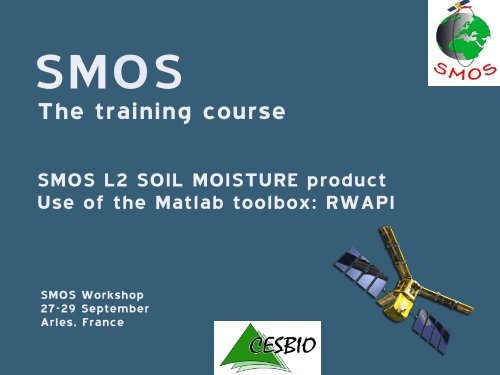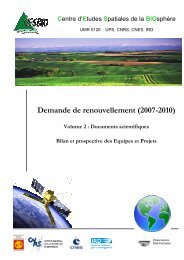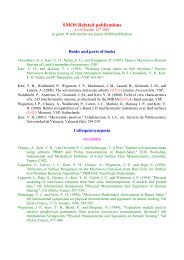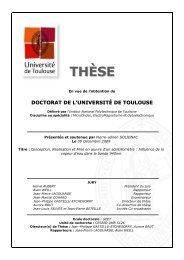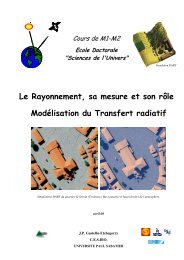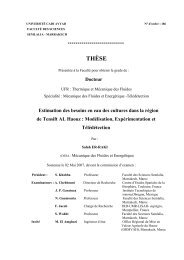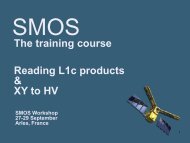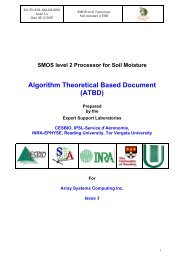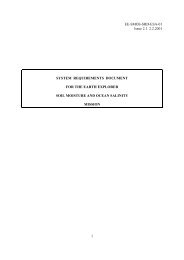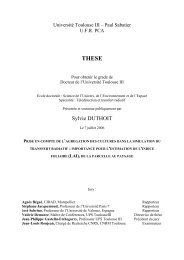Create successful ePaper yourself
Turn your PDF publications into a flip-book with our unique Google optimized e-Paper software.
SMOS<br />
The training course<br />
SMOS <strong>L2</strong> SOIL MOISTURE <strong>product</strong><br />
Use of the Matlab toolbox: <str<strong>on</strong>g>RWAPI</str<strong>on</strong>g><br />
SMOS Workshop<br />
27-29 September<br />
Arles, France
Aim of this talk<br />
� Give an overview of the soil moisture <strong>product</strong>: UDP, User Data Product<br />
� How to interpret some flags<br />
� reference to the main documents<br />
� Use of matlab toolbox « rwapi », developed by ARRAY Inc.<br />
But<br />
NOT present every field of the <strong>L2</strong> Soil Moisture <strong>product</strong><br />
No word about the DAP (if you have heard of it...courses at <strong>CESBIO</strong> !)
3<br />
Outline<br />
I) Documents<br />
II) How to derive <strong>on</strong> the Soil Moisture retrieval<br />
III) Read the <strong>L2</strong> <strong>product</strong>s with the <str<strong>on</strong>g>RWAPI</str<strong>on</strong>g><br />
IV) Examples
4<br />
Outline<br />
I) Documents<br />
II) How to derive <strong>on</strong> the Soil Moisture retrieval<br />
III) Read the <strong>L2</strong> <strong>product</strong>s with the <str<strong>on</strong>g>RWAPI</str<strong>on</strong>g><br />
IV) Examples
Documents<br />
2 doc.<br />
� Spec Level 2, describes all Inputs/Outputs files of the <strong>L2</strong><br />
� ATBD: algorithm to derive the soil moisture<br />
Where ?<br />
� <strong>CESBIO</strong> website: http://www.cesbio.ups-tlse.fr/fr/smos/smos_atbd.html<br />
� SMOSBlog
Documents<br />
Spec <strong>L2</strong> = all the details of Inputs / Output files
7<br />
Outline<br />
I) Documents<br />
II) How to derive <strong>on</strong> the Soil Moisture retrieval<br />
III) Read the <strong>L2</strong> <strong>product</strong>s with the <str<strong>on</strong>g>RWAPI</str<strong>on</strong>g><br />
IV) Examples
● <strong>L2</strong> <strong>product</strong>s: per ½ orbit<br />
UDP: User Data Product<br />
<strong>L2</strong> Soil Moisture course refresher<br />
● Ascending orbits: ~6 a.m. solar local time<br />
Descending orbits: ~6 p.m. solar local time<br />
● 2 files: *.HDR : Header<br />
*.DBL : Datablock,<br />
BINARY file, c<strong>on</strong>tains the data<br />
● <strong>L2</strong> soil moisture Grid : isea4h9, spatial resoluti<strong>on</strong> ~15 km<br />
BUT<br />
~15km<br />
Soil Moisture NOT retrieved over an hexag<strong>on</strong>al area<br />
●<br />
●<br />
●<br />
●<br />
●<br />
●<br />
●<br />
●
<strong>L2</strong> Soil Moisture course refresher<br />
9<br />
Antenna Pattern<br />
Weighted functi<strong>on</strong> : WEF<br />
To account for the radiometric sensitivity of<br />
SMOS instrument<br />
Emissi<strong>on</strong> of the Surface<br />
dielectric Model<br />
● Dobs<strong>on</strong> model (Dobs<strong>on</strong> et al. 1985)<br />
Mir<strong>on</strong>ov's model (Mir<strong>on</strong>ov et al, 2007)<br />
Nominal wet soil<br />
Water (Pure and Saline)<br />
● Simple empirical relati<strong>on</strong>ship<br />
Frozen soil<br />
Snow and Ice<br />
Barren rocks<br />
Urban<br />
Vegetati<strong>on</strong> Layer<br />
Radiative transfer model : L-Meb<br />
L band Microwave Emissi<strong>on</strong> of the Biosphere<br />
Wigner<strong>on</strong> et al. 2007<br />
�Atmosphere<br />
Water<br />
Low Vegetati<strong>on</strong><br />
Forest
<strong>L2</strong> Soil Moisture course refresher<br />
Surface classificati<strong>on</strong><br />
� For each DGG<br />
� Definiti<strong>on</strong> of a Working Area<br />
- 123 km x 123 km<br />
- Surface classificati<strong>on</strong>: Ecoclimap, at ~4km<br />
� Ecoclimap reclassified to 12 main classes<br />
10<br />
Low vegetati<strong>on</strong><br />
Forest<br />
Water<br />
Barren / rock soil<br />
Urban area<br />
Wetlands<br />
Str<strong>on</strong>g Topography<br />
Moderate Topography<br />
Wet Snow<br />
Mixed Snow<br />
frozen soil<br />
Ice cover<br />
Nominal =<br />
low vegetati<strong>on</strong><br />
Forest<br />
water<br />
~123 km<br />
⇒ Soil moisture derived ONLY<br />
LOW VEGETATION or FOREST fracti<strong>on</strong><br />
~123 km
<strong>L2</strong> Soil Moisture course refresher<br />
Surface classificati<strong>on</strong><br />
��Selecti<strong>on</strong> of a branch of the Decisi<strong>on</strong> tree<br />
ATBD, Table 18, « branches of the Decisi<strong>on</strong> Tree »<br />
��Selecti<strong>on</strong> of models for each of the classes of a Working Area<br />
ATBD, Table 20 « Selected models »<br />
4 dielectric models (ATBD, Table 19 « Structure of forward model »)<br />
MN = nominal: L-MEB (Dobs<strong>on</strong>'s)<br />
MW & MS = Water (Dobs<strong>on</strong>'s)<br />
MD = Cardioid model<br />
Snow<br />
Source: ATBD
12<br />
Outline<br />
I) Documents<br />
II) How to derive <strong>on</strong> the Soil Moisture retrieval<br />
III) Read the <strong>L2</strong> <strong>product</strong>s with the <str<strong>on</strong>g>RWAPI</str<strong>on</strong>g><br />
IV) Examples
<strong>L2</strong> soil moisture <strong>product</strong>: UDP -User Data Product-<br />
� Parameters of the model<br />
- SM<br />
- TAU<br />
- Hr : roughness<br />
- Surface Temperature<br />
- Dielectric c<strong>on</strong>stant<br />
- TB @ 42.5° (from models!)<br />
- their DQX = index, quality of the retrieval NOT an error compared to in-situ...<br />
- ...<br />
⇒ Retrieved = value<br />
Not retrieved = filled value, e.g. -999<br />
� Informati<strong>on</strong> about the c<strong>on</strong>diti<strong>on</strong>s: Science Flags<br />
forest, topography, rain, snow...<br />
� Evaluati<strong>on</strong> of the retrieval : C<strong>on</strong>fidence flags<br />
retrieval failed (FL_NO_PROD)<br />
is retrieved soil moisture within an expected range? its DQX ?<br />
quality of the models<br />
RFI c<strong>on</strong>taminati<strong>on</strong>s<br />
� C<strong>on</strong>diti<strong>on</strong>s of the retrieval: Processing Flags<br />
model used, initial tau c<strong>on</strong>diti<strong>on</strong>s, ..<br />
Source: Spec <strong>L2</strong>, Table 4.9 SM_SWATH Data Set Record
Tools to read SMOS <strong>product</strong>s<br />
*) BEAM + SMOS beam toolbox (See Ahmad's presentati<strong>on</strong>)<br />
● Where to find it : http://www.brockmannc<strong>on</strong>sult.de/cms/web/beam/software<br />
● What for ?<br />
→ L1C, <strong>L2</strong> UDP<br />
→ export data to ascii file<br />
*) <str<strong>on</strong>g>RWAPI</str<strong>on</strong>g> (Array Inc)<br />
● Matlab tool to read and extract data L1C, <strong>L2</strong> (UDP, DAP), input data …<br />
● Where to find it:<br />
C<strong>on</strong>tact Ali Mahmoodi : ali@array.ca …. offer him a beer<br />
Access to ftp site to download the toolbox
<str<strong>on</strong>g>RWAPI</str<strong>on</strong>g> with Matlab<br />
� Load a <strong>L2</strong> <strong>product</strong><br />
Matlab functi<strong>on</strong> : <str<strong>on</strong>g>RWAPI</str<strong>on</strong>g>.<strong>product</strong>.m<br />
Input = name of the directory c<strong>on</strong>taining the *HDR and *DBL<br />
Important !
Load Data for ALL nodes of the <strong>L2</strong> soil moisture <strong>product</strong><br />
�load all DGG
17<br />
Outline<br />
I) Documents<br />
II) How to derive <strong>on</strong> the Soil Moisture retrieval<br />
III) Read the <strong>L2</strong> <strong>product</strong>s with the <str<strong>on</strong>g>RWAPI</str<strong>on</strong>g><br />
IV) Examples<br />
Read retrieved data<br />
Flags
Extract informati<strong>on</strong> for 1 DGG and understand the results<br />
Example : 87406 th DGG of the <strong>L2</strong> <strong>product</strong>
Example 1:<br />
Retrieved parameters<br />
SM = 0.1672<br />
TAU = -999 (= not retrieved)<br />
..... WHY ?!
Example 1:<br />
SM retrieved but not TAU ....<br />
Is it expected ? a bug ? ... How to find why ?<br />
1) Call Philippe Richaume....<br />
I do !!<br />
Or<br />
2) look at the FLAGS of the UDP <strong>L2</strong> <strong>product</strong><br />
tables of the documents : ATBD and the <strong>L2</strong> specificati<strong>on</strong> <strong>product</strong>
Example 1<br />
Fracti<strong>on</strong> of →<br />
working area<br />
S_Tree1 : branch of the Decisi<strong>on</strong> Tree (see ATBD, table 18)<br />
� Threshold<br />
ATBD, Table 17, « Decisi<strong>on</strong><br />
Tree stage <strong>on</strong>e thresholds »<br />
WO : open water<br />
TS : str<strong>on</strong>g topography<br />
TM : moderate topo.<br />
SW: wet snow<br />
SM : Mixed snow<br />
FRZ : frozen soil<br />
FO : Forest<br />
NO : Nominal<br />
WL : Forest<br />
EB : Barren<br />
TI : Ice<br />
EU : Urban<br />
S_Tree1 = 12 ⇒ FNO > TH_NO: low vegetati<strong>on</strong> > 40% of the Working area
Example 1<br />
S_Tree2 : c<strong>on</strong>diti<strong>on</strong>s of the retrieval<br />
Use Table under table 4-9, doc. Spec <strong>L2</strong> to analyse the binary<br />
understand the flag = c<strong>on</strong>vert to a binary
Example 1<br />
00000001<br />
� Results : Retrieval c<strong>on</strong>diti<strong>on</strong>s<br />
- R2<br />
- Very low initial vegetati<strong>on</strong><br />
optical depth : TAU<br />
- Model used MN : L-Meb!<br />
S_Tree2 : c<strong>on</strong>diti<strong>on</strong>s of the retrieval<br />
Spec'<strong>L2</strong>, Table under table 4-9
Example 1<br />
S_Tree2 = 00000001<br />
��R2<br />
�� Very low initial TAU<br />
�� Model used MN : L-Meb<br />
From Table: �<br />
Initial std <strong>on</strong> Parameters<br />
to be RETRIEVED<br />
� Nil � not derived<br />
� Only SM retrieved<br />
S_Tree2: c<strong>on</strong>diti<strong>on</strong>s of the retrieval<br />
Source : ATBD, Page 89, Table 23
R2 R3 R4 ... what 's the difference ?<br />
� The more TBL1C the more parameters can be retrieved<br />
See in the <strong>L2</strong> <strong>product</strong> Value of M_AVA0 and M_AVA<br />
� If retrieval failed in R3 c<strong>on</strong>figurati<strong>on</strong><br />
� retrieval tried with R2, i.e. less parameters to be derived<br />
� R4: no more
Note:<br />
Initial TAU compared to 2<br />
thresholds: TH_Tau_R_ 23<br />
TH_Tau_R_34<br />
Defined in the AUX_CNFSMF:<br />
C<strong>on</strong>figurati<strong>on</strong> input file of<br />
<strong>L2</strong> processor<br />
Source : ATBD, Page 89, Table 23
Example 2<br />
DGG Id = 223130<br />
SM = - 999<br />
TAU = 0.4587<br />
SM not retrieved ....BUT TAU !!!!!!!
Example 2
Example 2<br />
Fracti<strong>on</strong> of the →<br />
working area<br />
S_Tree1 = 17 heterogeneous surface<br />
Working Area composed with<br />
Nominal < 40 %<br />
Forest < 60 %<br />
etc..<br />
Threshold defined<br />
in the ATBD, Table 17,<br />
« Decisi<strong>on</strong> Tree stage<br />
<strong>on</strong>e thresholds »<br />
WO : open water<br />
TS : str<strong>on</strong>g topography<br />
TM : moderate topo.<br />
SW: wet snow<br />
SM : Mixed snow<br />
FRZ : frozen soil<br />
FO : Forest<br />
NO : Nominal<br />
WL : Forest<br />
EB : Barren<br />
TI : Ice<br />
EU : Urban
Example 2<br />
S_Tree2 =00100110<br />
00100110<br />
��Retrieval c<strong>on</strong>diti<strong>on</strong>s<br />
● R3<br />
● Medium initial TAU<br />
● Model for the dielectric c<strong>on</strong>stant MD : cardioid<br />
Spec'<strong>L2</strong>, Table under table 4-9
Example 2<br />
S_Tree2 =00100110<br />
��Retrieval c<strong>on</strong>diti<strong>on</strong>s<br />
● R3<br />
● Medium initial TAU<br />
● Model for the dielectric c<strong>on</strong>stant MD : cardioid<br />
4 dielectric models (ATBD, Table 19 « Structure of forward model »)<br />
MN = nominal: L-MEB<br />
Water = MW & MS<br />
Cardioid = MD
Example 2<br />
S_Tree2 gives<br />
● R3<br />
● Medium initial TAU<br />
● Model used MD : cardioid<br />
��Parameters retrieved<br />
● Tau and the<br />
● Dielectric c<strong>on</strong>stant<br />
(CADIOID model)<br />
Source : ATBD, Page 89, Table 23
33<br />
Outline<br />
I) Documents<br />
II) How to derive <strong>on</strong> the Soil Moisture retrieval<br />
III) Read the <strong>L2</strong> <strong>product</strong>s with the <str<strong>on</strong>g>RWAPI</str<strong>on</strong>g><br />
IV) Examples<br />
Read retrieved data<br />
Flags
Flags
Science Flags<br />
Source, Spec' <strong>L2</strong> document, Table 4-11 « Structure of the Science Flags in the DSR »
Science Flags<br />
→ from Table 4.11 « Structure of the Science Flags in the DSR », Spec. <strong>L2</strong> document<br />
FL_TAU_FO : optical thickness > a defined threshold<br />
FL_External : FL_Rain or FL_TEC or N_Sky>0<br />
FL_Nominal<br />
FL_Forest : fracti<strong>on</strong> of forest > defined threshold<br />
FL_Scene_T<br />
FL_N<strong>on</strong>_Nom
C<strong>on</strong>fidence Flags<br />
Source: spec. <strong>L2</strong> document
C<strong>on</strong>fidence Flags<br />
5 th field: FL_NO_PROD = 1<br />
���������������� retrieval failed<br />
See Table 4-10 « Structure of the C<strong>on</strong>fidence Flag in the DSR »
No value reported in the UDP � No retrieval
Processing Flags<br />
Source: Spec'<strong>L2</strong>, Table 4-12
Processing Flags<br />
R3 retrieval was tried, failed � R2 attempted
Time series<br />
2 soluti<strong>on</strong>s<br />
� <str<strong>on</strong>g>RWAPI</str<strong>on</strong>g> matlab<br />
loop to read all your <strong>product</strong>s<br />
Find your DGG<br />
extract the data you want<br />
� Beam (see Ahmad's presentati<strong>on</strong>)<br />
either<br />
- From the Graphic User Interface : Task bar� Tools ��Export SMOS Grid Points<br />
- Linux, shell command (see Beam Help: export grid point)<br />
« sh /path_to_beam/beam-4.9.0.1/bin/export-grid-points.sh -box $l<strong>on</strong>min $l<strong>on</strong>max $latmin $latmax<br />
-o myfile /path2my<strong>product</strong>s/SM_????_MIR_*UDP*»
Time series<br />
Matlab example : functi<strong>on</strong> with a loop to read several <strong>L2</strong> soil moisture <strong>product</strong>s<br />
%% Extract Temporal serie<br />
serie = <strong>on</strong>es(length(List_Product),5) ;<br />
for ifile = 1:length(List_Product) ;<br />
% cd to <str<strong>on</strong>g>RWAPI</str<strong>on</strong>g> directory<br />
cd /home/mial<strong>on</strong>/Documents/SMOS/ToolBox/<str<strong>on</strong>g>RWAPI</str<strong>on</strong>g>/V14/test ;<br />
produitSMOS = <str<strong>on</strong>g>RWAPI</str<strong>on</strong>g>.<strong>product</strong>(List_Product{ifile}) ;<br />
% load dataset<br />
d=produitSMOS.dataset(1) ;<br />
% extract all DGGid of the <strong>product</strong><br />
dggid=d(:).Grid_Point_ID ;<br />
% find index of your DGG<br />
idxdgg = find(your_DGGid,dggid) ;<br />
% time of the overpass<br />
time = cat(2,double(d(idxdgg).Mean_Acq_Time.Days'),...<br />
double(d(idxdgg).Mean_Acq_Time.Sec<strong>on</strong>ds'),...<br />
double(d(idxdgg).Mean_Acq_Time.Microsec<strong>on</strong>ds')) ;<br />
serie(ifile,1) = d(idxdgg).Grid_Point_ID ;<br />
% extract Soil moisture<br />
serie(ifile,2) = d(idxdgg).Retrieval_Results_Data.Soil_Moisture ;<br />
% extract Soil Moisture DQX<br />
serie(ifile,3) = d(idxdgg).Retrieval_Results_Data.Soil_Moisture_DQX ;<br />
% extract TAU<br />
serie(ifile,4) = d(idxdgg).Retrieval_Results_Data.Optical_Thickness_Nad ;<br />
% extract TAU DQX<br />
serie(ifile,5) = d(idxdgg).Retrieval_Results_Data.Optical_Thickness_Nad_DQX ;<br />
% release memory !<br />
delete(d) ;<br />
delete(produitSMOS) ;<br />
end
44<br />
� <strong>CESBIO</strong> website<br />
Thanks for your attenti<strong>on</strong>...<br />
http://www.cesbio.upstlse.fr/fr/indexsmos.html<br />
ATBD document available = soil moisture retrieval algorithm<br />
http://www.cesbio.upstlse.fr/fr/smos/smos_atbd.html<br />
� <strong>CESBIO</strong> blog : many info, results, tools …<br />
http://www.cesbio.upstlse.fr/SMOS_blog/<br />
� ESA website<br />
http://earth.esa.int/SMOS/
Find DGG coordinates from any latitude / l<strong>on</strong>gitude<br />
Matlab functi<strong>on</strong> <strong>on</strong> SMOSBlog, tool page<br />
● Download the matlab fct :find_nearestDGG.m<br />
● .txt : file c<strong>on</strong>taining all the DGG and their coordinates<br />
Node of the grid DGG<br />
Each DGG has an ID (fixed : does not change with <strong>product</strong>s)
Example how to use find_nearestDGG.m<br />
Arles, DGG Id : 2018331 Latitude : 43.744 ° L<strong>on</strong>gitude : 4.619°


